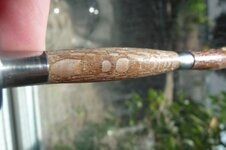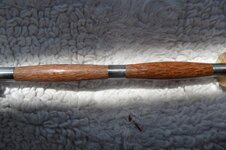David Conley
Member
Greetings.
I am new to the site (and turning) and appreciate the quality of advice and attitude I have seen here.
I am having trouble removing sanding dust from Leopardwood. I have read related posts on this site and others, and have yet to try everything, but want to get additional advice.
I started sanding with 120 through 400, then brass wool, on to micromesh and finished the pen with eee and Mylands, then noticed what I figure is sanding dust, so I started over so to speak, removing the finish using sandpaper and starting over on one piece.

I realized that during the original go-around, I had not removed the dust at each stage, so I did this time (or rather tried to) using the air hose at every stage, and one or more of the following: a Norton dry micro fiber towel, moistened paper towels, a polishing cloth, the bench brush, my finger nails, <repeat>. Nothing worked well except at the brass wool stage I think the most was removed.
I hesitated to use a tack cloth because on a previous blank I did not like the gum it left and felt it might make this situation worse.
I am just about to try a tooth brush and a dryer cloth - separately.
Here is a shot of the unfinished and finished piece.

Advice? Thanks in advance.
David
I am new to the site (and turning) and appreciate the quality of advice and attitude I have seen here.
I am having trouble removing sanding dust from Leopardwood. I have read related posts on this site and others, and have yet to try everything, but want to get additional advice.
I started sanding with 120 through 400, then brass wool, on to micromesh and finished the pen with eee and Mylands, then noticed what I figure is sanding dust, so I started over so to speak, removing the finish using sandpaper and starting over on one piece.

I realized that during the original go-around, I had not removed the dust at each stage, so I did this time (or rather tried to) using the air hose at every stage, and one or more of the following: a Norton dry micro fiber towel, moistened paper towels, a polishing cloth, the bench brush, my finger nails, <repeat>. Nothing worked well except at the brass wool stage I think the most was removed.
I hesitated to use a tack cloth because on a previous blank I did not like the gum it left and felt it might make this situation worse.
I am just about to try a tooth brush and a dryer cloth - separately.
Here is a shot of the unfinished and finished piece.

Advice? Thanks in advance.
David
Last edited:

